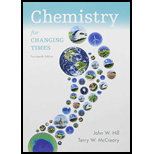
Concept explainers
Interpretation:
Two uses of CFCs should be listed.
Concept introduction:
CFCs stand for chlorofluorocarbons. These are non-toxic and nonflammable chemicals. These are halogenated saturated hydrocarbons which contain atoms of carbon, chlorine, and fluorine and produced as volatile derivative of
Answer to Problem 1RQ
Solution:
Chlorofluorocarbons are used as a cooling fluid in freezers and refrigerators. They are also used as a blowing agent for foams and packing material.
Explanation of Solution
Chlorofluorocarbons have wide applications due to its nontoxic and inflammable nature. They are used in refrigerators and freezers in the form of cooling fluids. They are also used as a blowing agent for packing materials and foams.
Chlorofluorocarbons causes depletion of ozone layer. In high atmosphere, the bonds between carbon and chlorine break to produce chlorine free radicals which destroy ozone.
Chlorofluorocarbons are used as a cooling fluid in freezers and refrigerators. They are also used as a blowing agent for foams and packing material.
Want to see more full solutions like this?
Chapter 13 Solutions
Chemistry For Changing Times and Modified Mastering Chemistry with Pearson eText -- ValuePack Access Card (14th Edition)
 ChemistryChemistryISBN:9781305957404Author:Steven S. Zumdahl, Susan A. Zumdahl, Donald J. DeCostePublisher:Cengage Learning
ChemistryChemistryISBN:9781305957404Author:Steven S. Zumdahl, Susan A. Zumdahl, Donald J. DeCostePublisher:Cengage Learning ChemistryChemistryISBN:9781259911156Author:Raymond Chang Dr., Jason Overby ProfessorPublisher:McGraw-Hill Education
ChemistryChemistryISBN:9781259911156Author:Raymond Chang Dr., Jason Overby ProfessorPublisher:McGraw-Hill Education Principles of Instrumental AnalysisChemistryISBN:9781305577213Author:Douglas A. Skoog, F. James Holler, Stanley R. CrouchPublisher:Cengage Learning
Principles of Instrumental AnalysisChemistryISBN:9781305577213Author:Douglas A. Skoog, F. James Holler, Stanley R. CrouchPublisher:Cengage Learning Organic ChemistryChemistryISBN:9780078021558Author:Janice Gorzynski Smith Dr.Publisher:McGraw-Hill Education
Organic ChemistryChemistryISBN:9780078021558Author:Janice Gorzynski Smith Dr.Publisher:McGraw-Hill Education Chemistry: Principles and ReactionsChemistryISBN:9781305079373Author:William L. Masterton, Cecile N. HurleyPublisher:Cengage Learning
Chemistry: Principles and ReactionsChemistryISBN:9781305079373Author:William L. Masterton, Cecile N. HurleyPublisher:Cengage Learning Elementary Principles of Chemical Processes, Bind...ChemistryISBN:9781118431221Author:Richard M. Felder, Ronald W. Rousseau, Lisa G. BullardPublisher:WILEY
Elementary Principles of Chemical Processes, Bind...ChemistryISBN:9781118431221Author:Richard M. Felder, Ronald W. Rousseau, Lisa G. BullardPublisher:WILEY





